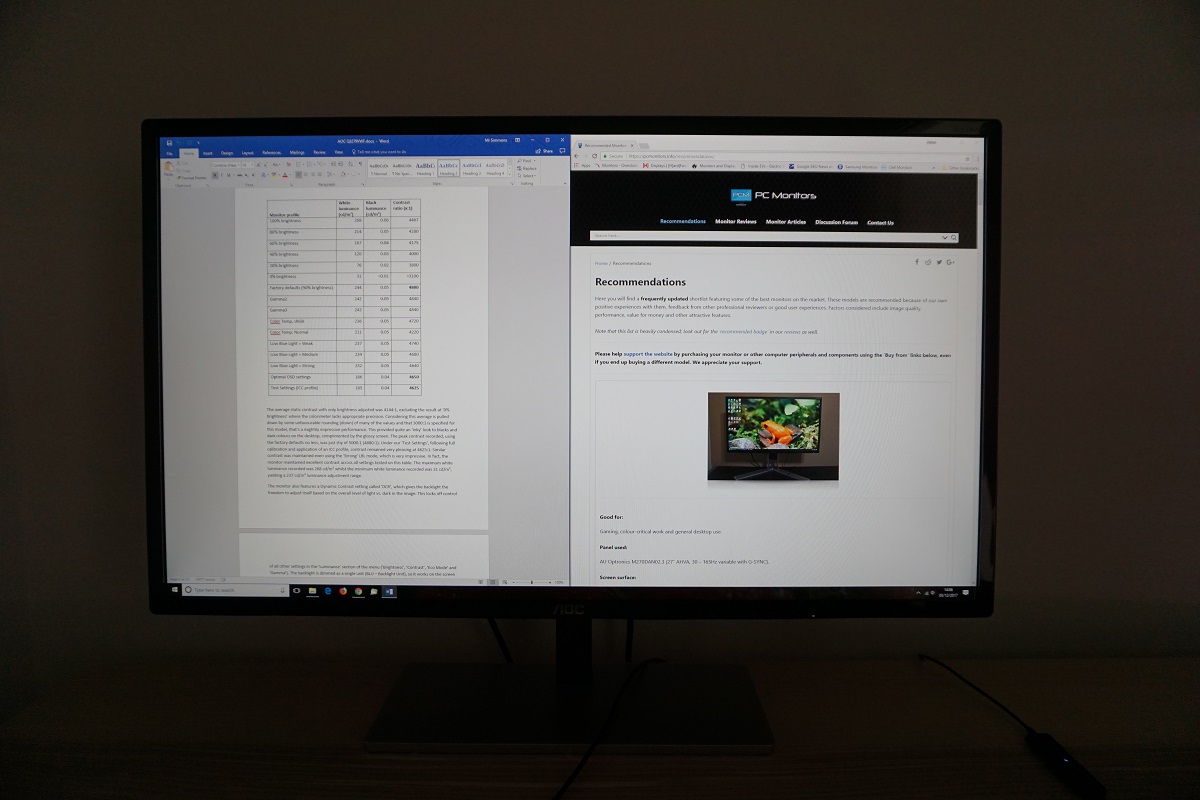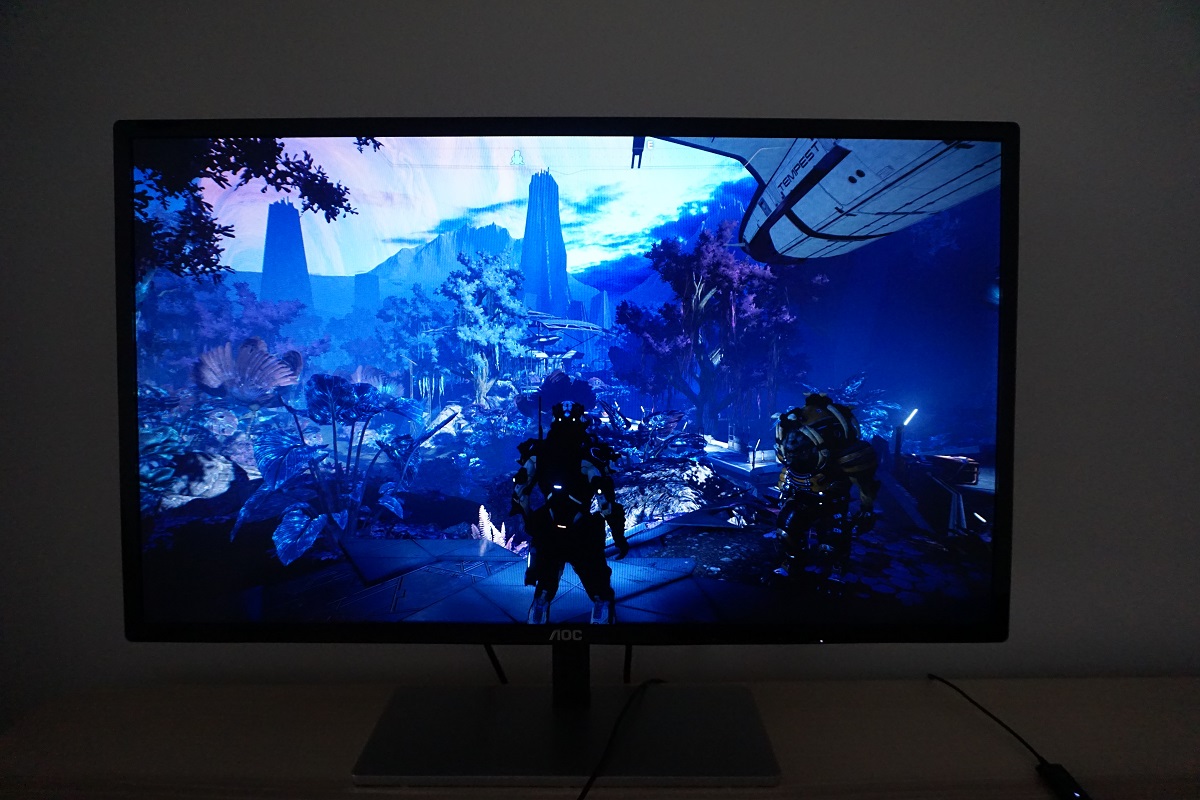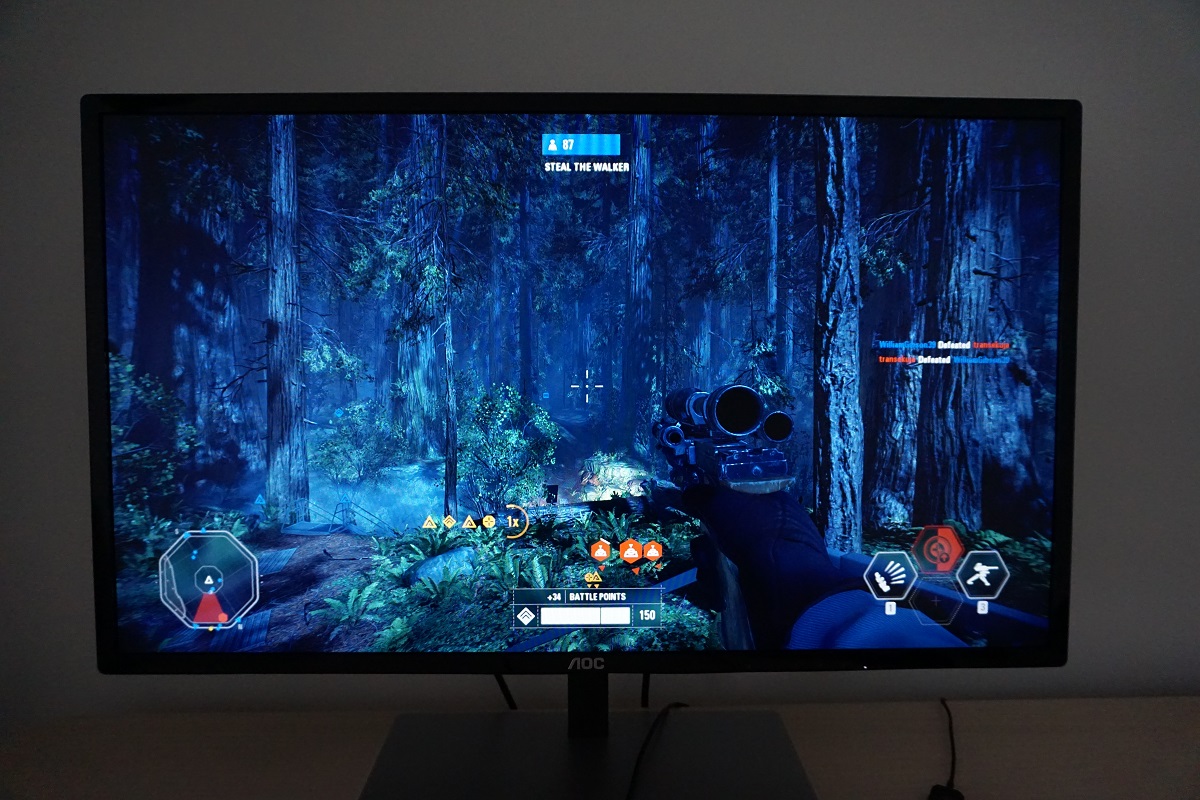Author: Adam Simmons
Date published: December 9th 2017
Table of Contents
Introduction
The 2560 x 1440 (WQHD) resolution represents a comfortable middle-ground for many users. It provides a nice boost in ‘pixel real-estate’ and (for a given screen size) clarity and detail potential, compared to 1920 x 1080 (Full HD). It doesn’t take things to the level of 3840 x 2160 (‘4K’ UHD) in these respects, but it doesn’t require the graphics grunt and can provide a potentially more comfortable pixel density for desktop tasks. The AOC Q3279VWF offers a 31.5” VA panel with 2560 x 1440 resolution. Other noteworthy aspects include support for AMD FreeSync and an enticing price tag. That isn’t something we often mention in a review introduction, but it is a real focus point for this model. We look past the cost and specifications, of course, and put this monitor through its paces in our usual suite of tests.
Specifications
The monitor uses a 31.5” MVA (‘Multi-domain Vertical Alignment) panel with support for a 75Hz refresh rate (Nvidia or AMD GPUs) and AMD FreeSync (compatible AMD GPUs only). 10-bit colour is supported through 8-bit + FRC dithering. A 5ms grey to grey response time is specified, with a free sachet of salt provided. Some of the key ‘talking points’ of this monitor have been highlighted in blue below.
The monitor has a simple design, with glossy black bezels and a rectangular stand base with a brushed-effect silver matte plastic upper surface. The bezels are of moderate thickness but even all around the monitor; ~14mm (0.55 inches) at all sides. They are single-stage, meaning they cover pretty much all the panel border. The most obvious thing when sitting in front of the monitor is the 31.5” screen. The screen has a glossy screen surface with a low haze matte anti-glare finish, as explored later. The OSD (On Screen Display) is controlled by pressable buttons on the underside of the bottom bezel, to the right of centre. There is also a small rectangular front-facing power LED that glows a very dim white when the monitor is on and dim amber when signal to the PC is lost and the monitor enters a low power state. The video below gives a run-through of the OSD menu system. From the side the monitor is quite slender – ~18mm (0.71 inches) at thinnest point, with more bulk lower down where the stand attaches. The stand offers tilt as the only ergonomic flexibility (2° forwards, 21.5° backwards). The bottom of the screen clears the desk by ~110mm (4.33 inches), whilst the top sits ~535mm (21.06 inches) above the desk. The total depth of the monitor including the stand is ~153mm (6.02 inches). So it should be noted that the stand is not too deep, which is good for users with minimal desk space who don’t want to place the monitor too close to their eyes. The rear of the monitor is black, with a brushed matte textured plastic for the top two thirds or so and a glossy black plastic lower down. The stand neck is semi-matte silver plastic. There are no VESA holes or any accommodation for alternative mounting. A 3rd party VESA adaptor by HumanCentric (B074JSJSF3) can be purchased on Amazon, if required. There is a Kensington security slot towards the bottom right, with backwards-facing ports to the left of this. These are; Dual-Link DVI, HDMI 1.4a (supports FreeSync), DP 1.2a (supports FreeSync), VGA and a 3.5mm headphone jack. A VGA cable, HDMI cable, DP cable and power cable is included in the box. The full refresh rate at the native resolution can be harnessed by either DP 1.2a or HDMI 1.4, via either an Nvidia or AMD GPU. FreeSync is also supported on compatible AMD GPUs. An HDMI cable, DP cable and USB 3.0 cable is included in the box alongside a power cable. The image below is a macro photograph taken on Notepad with ClearType disabled. The letters ‘PCM’ are typed out to help highlight any potential text rendering issues related to unusual subpixel structure, whilst the white space surrounding the text more clearly shows the actual subpixel layout alongside a rough indication of screen surface. A glossy screen surface with a very mild (low haze) anti-glare finish is used on this monitor. The smooth, shiny outer polarising layer allows the monitor to emit light without significant diffusion. The resulting image is crisp and clear without obvious graininess, there is just a light misty graininess in places that we didn’t find obtrusive. The image has good ‘vibrant pop’ in most lighting conditions due to the glossy nature of the screen surface. As shown in the image in the previous section, you get a bit of reflection due to the low level of diffusion compared to a more matte (higher haze) screen surface. The very mild anti-glare surface takes the edge off this reflection and keeps it looking darker and less pronounced than the sharp reflections you’d get on an untreated glossy surface. With the monitor switched on and in particular displaying brighter shades, the light from the monitor itself is effective in out-competing reflected light from the room. Darker content requires more careful moderation of lighting conditions, but you should avoid bright ambient light or light directly striking any screen surface. Further analysis on matte and glossy screen surfaces can be found in our dedicated article on the topic. The monitor has two different ‘preset’ types. There are the traditional (for AOC) ‘Eco Mode’ settings that simply adjust brightness to a certain preset value; ‘Standard’, ‘Text’, ‘Internet’, ‘Game’, ‘Movie’ and ‘Sports’. The other presets are ‘Game Mode’ settings; ‘FPS’, ‘RTS’, ‘Racing’, ‘Gamer 1’, ‘Gamer 2’ and ‘Gamer 3’. These lock off some of the OSD options, such as ‘Color’ and ‘Gamma’ settings and in some cases the entire ‘Luminance’ menu as well. They also impart varying levels of oversaturation and excessive sharpness. As explored in the OSD video, the final three numbered ‘Gamer’ presets provide access to a greater range of settings than the other ‘Game Mode’ options, but still lock off the ‘Color’ and ‘Gamma’ settings. Instead of testing every conceivable setting combination, including some we see little practicality in, we’ll be focusing on a few combinations which we find useful or interesting. The following table gives key readings (central gamma and white point) taken using a DataColor Spyder5ELITE colorimeter. General observations are also provided. The monitor was left in its ‘Plug and Play’ state without any additional drivers or ICC profiles specifically loaded. It was connected to a Club 3D Radeon R9 290 royalAce Free-Sync compatible GPU via DP 1.2, on a Windows 10 system. We performed some testing using an Nvidia GTX 1070 and found things very similar, for the purposes of this table. Unless otherwise stated (e.g. for our ‘Test Settings’), assume default settings were used. When viewing the figures in this table, note that for most PC users ‘6500K’ for white point and ‘2.2’ for gamma are good targets to aim for. Individual targets depend on individual uses, tastes and the lighting environment, however.
Features and aesthetics
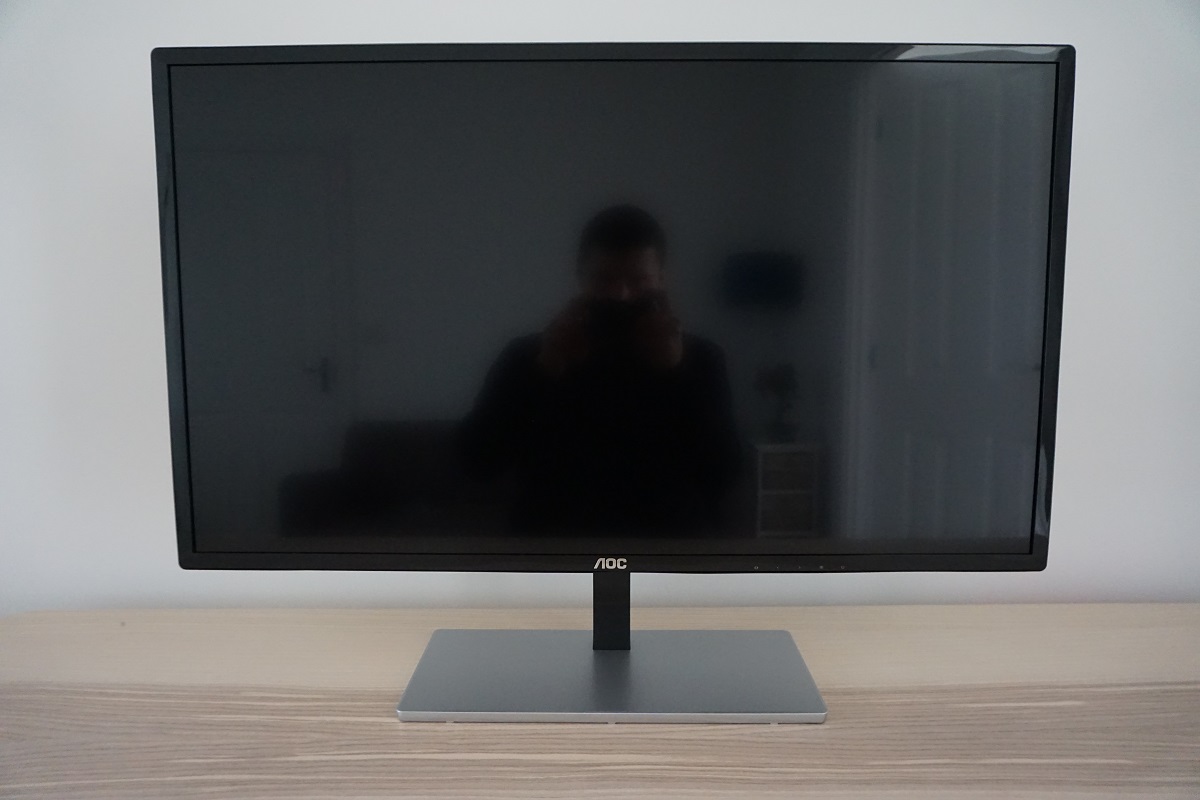
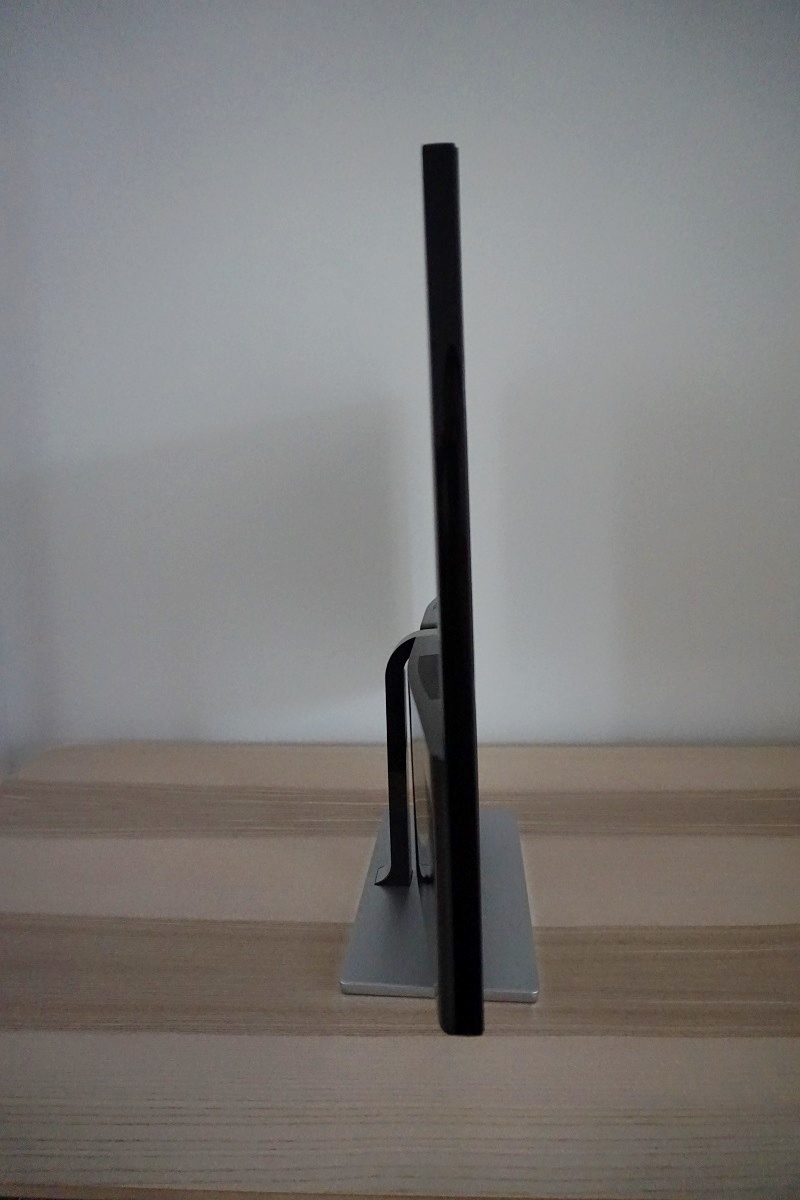
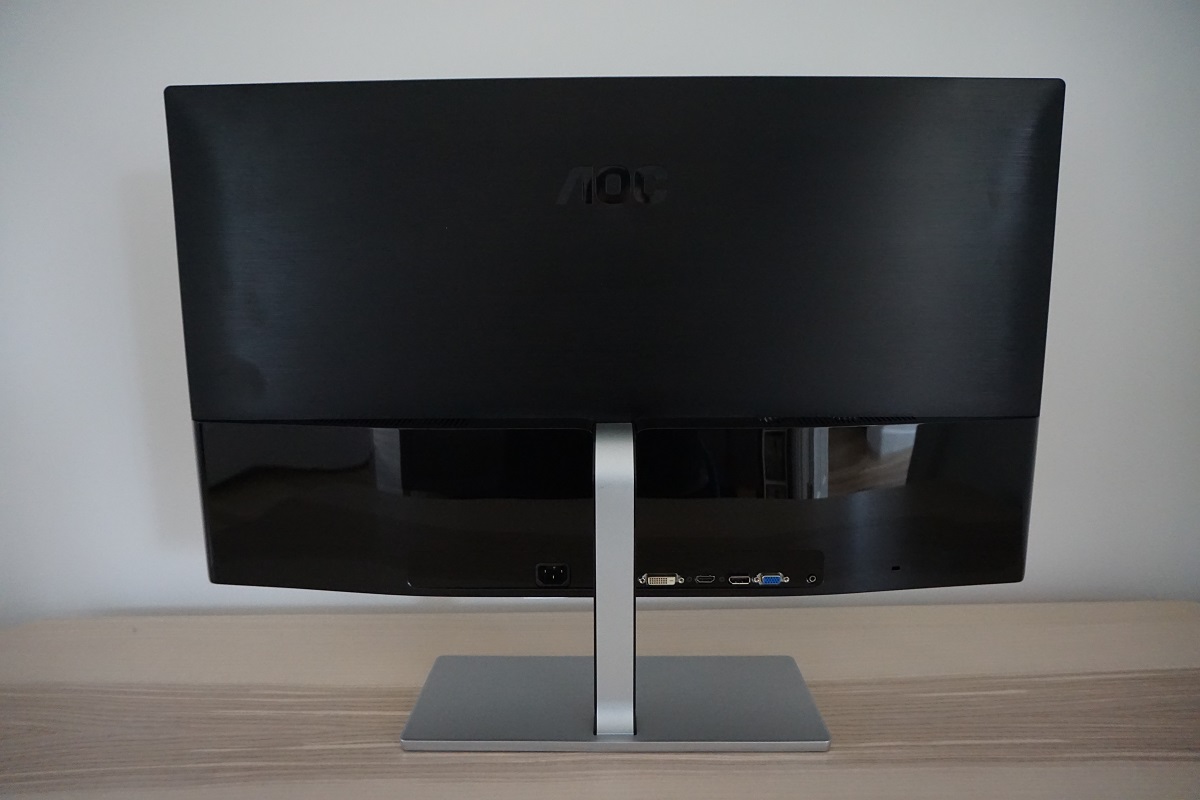
Calibration
Subpixel layout and screen surface
![]()
An RGB (Red, Green and Blue) stripe subpixel layout is used, which is the most common layout and the standard expected by modern operating systems such as Microsoft Windows and MacOS. Apple users therefore needn’t worry about text fringing from non-standard subpixel layouts, whilst Windows users don’t necessarily need to run ClearType. However; you may still wish to run ClearType to adjust according to preferences. The subpixel spacing and shape is quite normal and no issues were identified with respect to text rendering.
Testing the presets
Monitor Settings Gamma (central average) White point (kelvins) Notes Gamma1 (Factory Defaults) 2.0 6594K Quite bright with decent colour balance, aside from a slight blue-green bias affecting the neutrality of some grey shades. The image appears slightly washed out, with only some shades showing appropriate depth but many lacking in this area. As is usual for a VA model, some saturation is lost towards the edges and bottom of screen due to the gamma behaviour (viewing angle restrictions), further leaching depth in this area. Gamma2 1.9 6578K As above but gamma reduced and image appears less saturated and rather lacklustre overall. Gamma3 2.1 6580K As ‘Gamma1’ but with gamma brought closer to the ‘2.2’ target, centrally. This brings a bit of extra depth to the image, although some shades could still do with extra depth. Color Temp. sRGB 2.1 6859K The image appears slightly cool and appears sapped of depth in some respects, with saturation noticeably lower for some shades. This is an ‘sRGB emulation’ mode that restricts the colour gamut. Color Temp. Normal 2.0 7655K The image appears very cool and not really ‘normal’ at all. Similar to factory defaults aside from that. Low Blue Light = Weak 2.0 6014K This is a weak ‘Low Blue Light’ (LBL) setting. The image appears somewhat warmer than default with a slight reduction in blue light output from the screen. Low Blue Light = Medium 2.0 5648K A slightly stronger LBL setting, further reducing the blue colour channel and reducing blue light output from the monitor. Low Blue Light = Strong 2.0 5347K The strongest LBL preset on the monitor, providing another step down in blue light output and a slightly warmer look to the image again. This is suitable for relaxing evening viewing or other times when you wish to limit blue light exposure. Although we would have preferred a slightly stronger LBL setting that brings the white point below 5000K. Optimal OSD settings (see below) 2.1 6508K As ‘Gamma3’ with more comfortable brightness and slight white point adjustments. The grey neutrality issues remain and some shades are still lacking a bit of depth. Test Settings (ICC profile applied, see below) 2.2 6502K As ‘Optimal OSD settings’ with an ICC profile applied. This improves gamma tracking and enhances shade depth. The image appears vibrant and varied overall. The good gamma tracking combined with reasonably generous colour gamut and glossy screen surface provide a nice ‘pop’ to the image. Although an even more generous colour gamut and greater colour consistency would further enhance this.
Out of the box the monitor was quite bright, although not to the extent we’ve seen on some monitors recently. There was a slight cool-green tint to some grey tones, but overall white point balance was good. The image significantly lacked saturation to some shades, although was quite vibrant in some areas. This was improved a bit by changing the ‘Gamma’ setting, although not entirely alleviated. The relatively smooth, glossy screen surface helped perceived vibrancy in many lighting conditions. The images below show the gamma tracking using the ‘Optimal OSD Settings’ (top image) and our ‘Test Settings’ (bottom image). You can see a sagging of the gamma curve in the top image, which was responsible for a bit of undersaturation and lack of depth overall. The bottom image shows the gamma curve adhering far more closely to the ‘2.2’ curve, following correction with an ICC profile.

Gamma 'Optimal OSD Settings'

Gamma 'Test Settings' (ICC profile applied)
The monitor also includes some ‘Low Blue Light’ settings that are fairly easy to access in the OSD. We would prefer to be able to quickly enable and disable such settings using hotkeys, but because of how it is implemented that isn’t possible. The LBL setting is applied globally, you can’t associate a particular LBL setting with one of the ‘Gamer’ profiles without it applying universally. That means it takes a little bit more time to activate and deactivate than simply switching between profiles – a minor inconvenience, but one worth noting. We like to activate the ‘Strong’ LBL setting in the evening for our own viewing pleasure and deactivate it during the daytime or during testing. Blue light keeps the body alert and affects your ‘sleep hormones’, so it’s best to cut this out as much as possible in the hours leading up to sleep. Note that these LBL settings are applied over the top of the ‘Color Setup’ settings, so what you select in that section of the OSD influences the result as well.
Optimal OSD Settings
Shifting from the default gamma setting of ‘Gamma1’ to ‘Gamma3’ helped achieved superior gamma tracking and shade depth. Things still weren’t quite where we would like them in either respect, but there was no way to further improve the image in the OSD alone without upsetting other aspects of image quality. Which is why we ultimately profiled the monitor for our ‘Test Settings’. We also reduced brightness significantly and made a few tweaks to the colour channels. We’ve included the ‘Overdrive’ setting and ‘Refresh rate’ used, just for reference. Although ‘75Hz’ was the default setting via DP on both our AMD and Nvidia GPUs, anyway. Assume that any setting not mentioned, including contrast, was left at default. Overdrive= Weak Gamma= Gamma3 Color Temp= User R= 50 G= 49 B= 49 Refresh rate (Windows setting)= 75Hz
Brightness= 68 (according to preferences and lighting)
Test Settings (ICC profile)
We created an ICC profile using our Spyder5ELITE colorimeter to improve gamma tracking and make further refinements to the image beyond what could be done with OSD tweaking alone. The ‘Optimal OSD settings’ above were used as a base, over which our ICC profile was applied on top. Note that the ICC profile is specific to our unit and, along with the OSD settings, it may not be optimal for all units. You can use the profile in combination with whatever brightness or colour channel adjustments you require. To make use of our profile do the following:
2) Set the monitor up according to the ‘Optimal ‘OSD settings’, although further adjustments can be made if desired. Using a brightness of ‘68’ provided ~180 cd/m² on our unit with the ICC profile applied.
3) This article provides instructions on activating the profile as well as some limitations to be aware of when gaming in particular. Games do generally respond to the profile or at least apply the gamma correction – even without the profile, the image appears fairly rich rather than washed out anyway.
Contrast and brightness
Contrast ratios
A BasICColor SQUID 3 (X-Rite i1Display Pro) was used to measure the luminance of white and black using a range of monitor settings. From these values, static contrast ratios were calculated. Results are show in the table below, with blue highlights indicating the results for our ‘Optimal OSD settings’ and ‘Test Settings’. Black highlights indicate the highest white luminance, lowest black luminance and highest contrast ratio recorded. Assume any setting not mentioned was left at default, with the exceptions already noted in the calibration section.
| Monitor Settings | White luminance (cd/m²) | Black luminance (cd/m²) | Contrast ratio (x:1) |
| 100% brightness | 268 | 0.06 | 4467 |
| 80% brightness | 214 | 0.05 | 4280 |
| 60% brightness | 167 | 0.04 | 4175 |
| 40% brightness | 120 | 0.03 | 4000 |
| 20% brightness | 76 | 0.02 | 3800 |
| 0% brightness | 31 | <0.01 | >3100 |
| Factory defaults (90% brightness) | 244 | 0.05 | 4880 |
| Gamma2 | 242 | 0.05 | 4840 |
| Gamma3 | 242 | 0.05 | 4840 |
| Color Temp. sRGB | 236 | 0.05 | 4720 |
| Color Temp. Normal | 211 | 0.05 | 4220 |
| Low Blue Light = Weak | 237 | 0.05 | 4740 |
| Low Blue Light = Medium | 234 | 0.05 | 4680 |
| Low Blue Light = Strong | 232 | 0.05 | 4640 |
| Optimal OSD Settings | 186 | 0.04 | 4650 |
| Test Settings (ICC profile) | 185 | 0.04 | 4625 |
The average static contrast with only brightness adjusted was 4144:1, excluding the result at ‘0% brightness’ where the colorimeter lacks appropriate precision. Considering this average is pulled down by some unfavourable rounding (down) of many of the values and that 3000:1 is specified for this model, that’s a mightily impressive performance. This provided quite an ‘inky’ look to blacks and dark colours on the desktop, complimented by the glossy screen. The peak contrast recorded, using the factory defaults no less, was just shy of 5000:1 (4880:1). Under our ‘Test Settings’, following full calibration and application of an ICC profile, contrast remained very pleasing at 4625:1. Similar contrast was maintained even using the ‘Strong’ LBL mode, which is very impressive. In fact, the monitor maintained excellent contrast across all settings tested on this table. The maximum white luminance recorded was 268 cd/m² whilst the minimum white luminance recorded was 31 cd/m², yielding a 237 cd/m² luminance adjustment range.
The monitor also features a Dynamic Contrast setting called ‘DCR’, which gives the backlight the freedom to adjust itself based on the overall level of light vs. dark in the image. This locks off control of all other settings in the ‘Luminance’ section of the menu (‘Brightness’, ‘Contrast’, ‘Eco Mode’ and ‘Gamma’). The backlight is dimmed as a single unit (BLU – Backlight Unit), so it works on the screen as a whole rather than accounting properly for intricate mixtures of shades. The mode did work in that the backlight adjusted rapidly to changes in scene brightness. It also dimmed quite effectively for very dark content, but tended towards a perhaps inappropriately bright level for mixed content. We prefer manual control over the backlight on models where it is all controlled as an individual unit, more so when the static contrast performance is as strong as it is here.
PWM (Pulse Width Modulation)
The monitor uses DC (Direct Current) to dim the backlight and does not use PWM (Pulse Width Modulation) at any brightness setting. The backlight is therefore considered ‘flicker-free’, which will come as welcome news to those who are worried about side-effects from PWM usage.
Luminance uniformity
Whilst observing a black screen in a dark room we observed no obvious backlight bleed. There was minor clouding in places, most noticeable but still minor towards the top right of the screen. This is shown in the image below, which was taken in a dark room using our ‘Test Settings’ and camera settings which are representative of what the eye sees when observing the screen. The image was taken a sufficient distance back from the screen to eliminate so-called ‘VA glow’. This is a silver-purple glow that’s visible towards the bottom of the screen, in particular, from a normal viewing position. If you more to a sharper viewing angle relative to the screen, it blooms out more noticeably. It’s nowhere near as obtrusive as ‘IPS glow’ nor does it impact fine detail in dark scenes to the same extent. Note that individual units vary when it comes to backlight bleed. The luminance uniformity was fair. The maximum luminance was recorded at ‘quadrant 5’ in the centre of the screen (163.9 cd/m²). The greatest deviation from this occurred at ‘quadrant 2’ above centre (142.8 cd/m², which is 13% dimmer). The remaining quadrants showed 3 – 11% deviation from the brightest point, which is reasonable. Note that individual units vary when it comes to uniformity and you can expect further deviation beyond the points measured. The following graphic is a contour map which shows these deviations in a more artistic way. It uses darker greys to represent lower luminance levels and hence greater deviation from the brightest point than lighter greys. The percentage deviation between each quadrant and the brightest point recorded is also provided. We also measured colour temperature (white point) uniformity for these same quadrants. Deviations here are shown in the contour map below and are assigned DeltaE values. A higher value indicates greater deviation from the 6500K (D65) daylight white point target than lower values. Here, a DeltaE <3 is considered non-significant deviation that most users wouldn’t readily notice by eye. Greater deviations are also displayed with stronger (deeper) yellow shades in the graph. Results here are quite good overall. The point nearest 6500K was recorded as the central quadrant, with a maximum deviation of DeltaE 3.4 towards the bottom right. This is considered significant according to this test, although no further significant deviations were recorded. It’s again important to remember that individual units vary when it comes to uniformity and that you can expect further deviations beyond the measured point. It’s also worth remembering that VA models such as this have perceived shifts that aren’t accounted for by these readings, due to viewing angle weaknesses. On Battlefield 1 (BF1) the monitor provided an excellent contrast performance overall. Bright shades contrasted with dark surroundings very nicely, with excellent ‘pop’ and clarity. There was only a light misty graininess from the screen surface, leaving lighter shades appearing relatively smooth. The glossy screen surface aided perceived contrast where some ambient light struck the screen surface, giving a ‘wet’ and inky look to the image. Even in dimmer conditions, though, the strong static contrast of the monitor gave dark shades a nice inky look. The underside of rocks, bridges and vegetation in shaded patches and dark building interiors built up an impressive atmosphere. There was a bit of ‘black crush’, whereby some of the darker shades were perceived as even darker than intended from a normal viewing position and essentially blend into a dark mass. This was strongest centrally, with these dark shades lightening up and detail levels improving if you view the screen from an angle or observe peripheral sections of the screen. This is related to perceived gamma shifts due to weaknesses in the viewing angle behaviour of VA panels. It always exists to a degree on VA panels, but we’d say on this one it was reasonably minor. Not as good as we’ve seen on some recent curved Samsung SVA panels, but not as bad as on some models. There was also a bit of ‘VA glow’ towards the bottom of the screen, which lightened things up a bit. As with the ‘black crush’, though, we felt the overall atmosphere was appropriate in dark scenes and such scenes were presented in a nicer way than on non-VA LCDs. Dirt Rally also reflected this strong contrast performance. There was plenty of scope to test that aspect when driving at night on this game, as the nights are truly dark. The monitor provided good deep dark shades with brighter elements, such as car headlights, piercing through the darkness with excellent ‘pop’. The glossy screen surface again aided the perceived contrast in some lights and kept things looking relatively smooth and clear. There was some ‘black crush’ and ‘VA glow’, but the overall level of detail in dark areas remained quite pleasing. Some more subtle details such as tire tread patterns and crinkled leather car interiors were not as distinct as they could be, but still visible. There was no major loss of detail and there was certainly not the kind of ‘flooded look’ you’d get on your typical IPS-type panel of this sort of size. We also assessed contrast performance in the Blu-ray of Star Wars: The Force Awakens. The monitor gave this title exactly the kind of look it craved, with deep and dark areas of space lit up by brilliant flashes from explosions, flames, sparks and light sabers. We didn’t feel any of the weaknesses in contrast performance mentioned previously really detracted from the excellent atmosphere created on this film. The strong static contrast performance and glossy screen surface did their thing here. It is also worth noting that this film is presented in a 16:9 letterbox format, with black bars at the top and bottom of the screen. These appeared nice and deep and fairly inky, even in fairly dim viewing conditions. Lagom’s contrast tests were used analyse specific strengths and weaknesses in contrast performance. The following observations were made. The colour gamut of the Q3279VWF (red triangle) is compared with the reference sRGB colour space (green triangle) in the image below. The monitor offers quite comprehensive sRGB coverage (98%) with a little under-coverage and also some overextension on the green to red region of this diagram. This allows the monitor to inject a little bit of extra vibrancy to some shades without the strength of saturation seen on models with more generous colour gamuts. For the intended purposes of this monitor and general usage this works quite well, although some users might have appreciated a little more extension beyond sRGB. The monitor also provides an sRGB emulation mode (‘Color Temp. sRGB’) which gets rid of the slight overextension in the gamut. Unfortunately the gamut now undershoots the sRGB target by some way, according to our measurements (94% sRGB). Users who wish to use this monitor for colour-critical work should be aware of the colour consistency limitations raised in this review. If they still deem it suitable and have access to a colorimeter, the native gamut of the screen would probably make a better base of calibration for accurate shade reproduction. On BF1 the monitor provided a good array of vibrant-looking shades. The warm orange glow of embers and roaring fires and some fairly lush-looking green trees were presented in quite an eye-catching way. There was a nice array of more muted greens and good rich woody brown hues in the mix as well, keeping environments in the game looking vivid but natural. There was a noticeable loss of saturation towards the edges and bottom edge of the screen (and even near the very top), with such shades losing a bit of their lustre there. The saturation shifts are related to perceived gamma changes and viewing angle weakness. This was quite pronounced on red shades, affecting some of the characters skin tones so that they went from appearing quite human centrally to a bit ill-looking and very much off-colour towards the extreme edges of the screen. Earthy brown tones lost some of their richness as well, appearing more of a clay-like colour rather than a rich earthy shade in affected regions. Because this is such a large screen and most gamers will be focusing on the action in the centre of the screen, these shifts aren’t necessarily going to be bothersome or even noticeable. And they weren’t as extreme as the saturation losses you see on TN models when observing shades higher up vs. lower down the screen. They were more pronounced than we’ve seen on modern Samsung and AUO VA panels used in the likes of the AOC AG322QCX and BenQ PD3200Q, however. Dirt Rally highlighted similar strengths and weaknesses. The saturation shifts meant that apparent shade variety for subtler green hues was reduced and that some of the lusher forest green shades appeared less vivacious peripherally. Nonetheless, the environments had quite a rich look overall and appeared vivid but natural. The monitor got to showcase a good range of vibrant shades where car liveries were concerned, with the glossy screen surface giving these shades a nice ‘wet’ and ‘painted on’ look in some lights which matte screens simply don’t give. Particularly when observed in the central bulk of the screen, there were some excellent deep purples and reds and some nice rich golden yellow hues as well. Some of these shades weren’t as lively as they would have been if the colour gamut were more generous, but appeared far from ‘washed out’ on the whole. We also tested the Blu-ray of Futurama: Into the Wild Green Yonder. This is a particularly unforgiving test for colour consistency, with large areas of individual shade being displayed in many scenes. Unsurprisingly, it highlighted some of the weaknesses here. One of the main characters, Dr Zoidberg, appeared an appropriate if not slightly too vibrant red centrally and appeared quite anaemic towards the flanks and bottom of the screen. Character skin tones also changes significantly depending on where on the screen they were displayed. The monitor was still able to provide an appropriate look to different ‘shade classes’ on this title, though. Pastel shades looked relatively muted whilst deeper shades generally looked appropriately deep and neon shades nice and bright and eye-catching. In fact, there were some shades from this last category which were particularly noteworthy in their vibrancy. There were some excellent neon greens, yellows and pinks – standing out particularly well against darker backgrounds. The strong contrast performance and glossy screen helped bring these shades to the viewer’s attention with a nice vibrant ‘pop’. Lagom’s tests for viewing angle tests were used to analyse colour consistency and viewing angle performance in a more specific way. The following observations were made from a normal viewing position, eyes around 70-80cm from the screen. Perceived changes in gamma and saturation can be more pronounced if you sit closer to the screen. On some monitors faint interlace patterns can be seen during certain transitions, particularly noticeable where light shades (muzzle flashes, explosions etc.) briefly pop up on the screen. These are sometimes referred to as ‘pixel inversion artifacts’, but we prefer the more descriptive term; ‘dynamic interlace pattern artifacts’. Alternatively, static interlace patterns can be seen with some shades appearing as faint horizontal bands of a slightly lighter and slightly darker version of the intended shade. We did not observe any dynamic interlace pattern artifacts on this model. We did observe some extremely faint static interlace patterns, however. They were generally constrained to the bottom of the screen, where they appeared as vertical stripes of a slightly lighter and darker alternation of the intended shade. Or the far left, where they appeared to slope upwards diagonally. It’s possible these were ‘cross hatching’ imperfections on the screen surface. They were not specific to certain shades and appeared even with white content. At any rate they were extremely faint and not something most users would notice, with some struggling to see them even if they were specifically pointed out on the screen. We’re just mentioning them for completeness. A small utility called SMTT 2.0 was used alongside a sensitive camera to analyse the latency of the Q3279VWF, with over 30 repeat readings taken to improve accuracy. Using this method, we calculated 3.95ms (under 1/3rd of a frame at 75Hz) of input lag. This value was not influenced by enabling one of the ‘Game Mode’ presets in the OSD. We have no way to accurately measure input lag in the variable refresh rate and frame range environment under which FreeSync would be active, however. This value is influenced by both the element you ‘see’ (pixel responsiveness) and the element you ‘feel’ (signal delay). It indicates a very low signal delay, which even sensitive users shouldn’t take issue with. In our responsiveness article we explore the key factors affecting monitor responsiveness. One of the key concepts explored here is ‘perceived blur’, which is caused predominantly by the movement of your eyes as you track motion on the screen. It is also influenced by pixel responsiveness, although this is generally a less significant (but still important) factor on modern monitors. We also explore ‘pursuit photography’, a technique which uses a moving camera to capture motion on a monitor in a way that reflects both of these elements of perceived blur. This is something that normal static photography or video can’t capture. The following images are pursuit photographs taken using the UFO Motion Test for ghosting, with the test running at its default speed of 960 pixels per second. This is a practical speed for taking such photographs and sufficient to highlight both elements of perceived blur. The UFOs move across the screen from left to right at a frame rate matching the refresh rate of the display. The monitor was set to 60Hz and 75Hz using the full range of ‘Overdrive’ settings; ‘Off’, ‘Weak’, ‘Medium’ and ‘Strong’. All rows of the test were used, with the backgrounds showing various shade levels (dark, medium and light). The final column shows a reference screen (Dell S2417DG), which is able to perform pretty much optimally at 60Hz without obvious weaknesses in pixel responsiveness. At 60Hz you can see that the object itself looks relatively soft and unfocused, without clearly defined details. This reflects a moderate amount of perceived blur caused by eye (camera) movement. You can also see various degrees of trailing behind the object. The boldest and most extensive trailing can be seen for the dark background, shown in the top row. This is reduced slightly by increasing the ‘Overdrive’ setting, although it is replaced with a dity-looking trail of inverse ghosting (overshoot) for the ‘Strong’ setting. The medium cyan background (middle row) shows some improvement using the ‘Weak’ setting compared to ‘Off’, whilst the ‘Medium’ setting increases the levels of overshoot (dark shadowy trailing) behind the cockpit area in particular, without really reducing the conventional trailing. The ‘Strong’ setting introduces obvious bright and colourful overshoot. For the lightest background, there is little difference between ‘Off’ and ‘Weak’, whilst ‘Medium’ is also fairly similar but has slightly increased levels of overshoot. The ‘Strong’ setting again introduces obvious overshoot. At 75Hz the object itself becomes marginally narrower, although it still remains rather unfocused. This reflects a slight reduction in perceived blur, but still a moderate amount compared to what you’d see at significantly higher refresh rates. The trailing characteristics are fairly similar to at 60Hz. However; because the object itself is narrower and the screen updates more frequently, the pixel responsiveness requirements are increased. You can see the trailing becomes slightly more extended, again boldest with the dark background. The ‘Medium’ setting again looks similar to ‘Weak’, but with a bit of extra overshoot. Whilst the ‘Strong’ setting remains utterly useless due to extreme overshoot. We studied a much broader range of pixel transitions not specifically documented here, both in game and using TestUFO, and came to the conclusion that ‘Weak’ is the optimal setting on this monitor. There was a noticeable reduction in trailing compared to ‘Off’ for quite a few pixel transitions (especially where various ‘medium’ shades were involved), without troubling levels of overshoot being introduced. The ‘Medium’ setting did little to reduce conventional trailing, it simply intensified the overshoot. Whilst ‘Strong’ sort of speaks for itself even in the more limited pursuit photography testing above. Note that we will not be including a section on ‘overclocking’ in this review as the monitor lost signal when set much above 75Hz. On Battlefield 1 (BF1), the 75Hz refresh rate provided some advantages over a 60Hz refresh rate. Where the frame rate kept up, at least. Most noticeably, the ‘connected feel’ as you interacted with your character in the game was improved. The precision and ‘flow’ as you move your character in the game, particularly with the mouse, is improved. There was also a slight decrease in perceived blur, with the monitor pumping out more information every second and therefore reducing eye movement. The monitor also provided a decent enough performance for quite a few pixel transitions to make good use of its 75Hz refresh rate. For most pixel transitions, between medium and lighter shades, there was very little between the performance of this and the fastest 75Hz LCDs. There was a bit of extra powdery trailing for some transitions and also some overshoot (bright trailing), but neither issues was particularly eye-catching with the ‘Weak’ overdrive setting, in our view. Individual sensitivity to such things does vary, however. There were definite imperfections where darker shades were involved in the transitions, however. Some of the pixel transitions were noticeably sluggish, giving some ‘smeary’ trailing that even appeared ‘smoke-like’ in the worst cases. There was also some ‘break-up’ trailing, whereby colours that appear almost black but contain other hues (such as red or purple) will have the more colourful hue appear to leach out. We liken this to wetting fountain pen ink on paper, where the ink will run a bit. These imperfections occur to a degree on all VA panels, but were more pronounced and widespread on this model compared to some other large VA models we’ve used recently. Such as those using AUO’s AMVA+ panels or curved Samsung SVA panels. For example the Samsung C34F791 and the AOC AG322QCX). The weaknesses were not as pronounced as we’ve seen on various older VA models (EW2430 and older) nor on the recent but rather sluggish Philips BDM4037UW. The video below runs through these imperfections and provides visual demonstrations. It also stresses the important point that not everybody will find these imperfections bothersome and given the other strengths of the monitor, don’t automatically dismiss it because of these weaknesses. We tested a range of other titles, such as Dirt Rally, and found similar strengths and weaknesses became apparent on the monitor. Dirt Rally is quite unforgiving when it comes to high-contrast transitions, particularly when racing at night where they were very widespread. Looking at trees against a dark hill in the background or that same hill against a blue midnight sky created an almost watercolour painting effect. Quite a bit of smeary trailing and a generally more dizzying experience than was necessary. We’d still consider the game playable, but these imperfections were difficult not to notice in such scenarios. Driving in the daytime generally presented transitions the monitor was more comfortable with, with weaknesses being restricted to a bit of inverse ghosting or some light powdery trailing in places. We also tested our Blu-ray film titles, which didn’t highlight the weaknesses in the same way. That is because the 24fps or so at which these titles run essentially breaks up the action and reduces the pixel responsiveness requirements for ‘optimal performance’ quite considerably. So, for the most part, things looked about as good as you’d usually see when watching these films. There were some pixel transitions that were slow enough to cause some slight issues here, though. There was a little bit of ‘break-up’ trailing in places, with some dark objects appearing with a slight and non-extensive ‘fringe’ of purple, red or other colours. This was short lived, sharp and overall quite tame compared to the ‘break-up’ trailing observed at higher frame rates. There were also occasional after images, particularly where the scene would change from very dark to very bright quickly. This was a momentary effect and quite faint, but still something we observed. We sometimes saw this when scrolling through content on the internet as well, but didn’t find it bothersome. It should be noted that, although a lot of movie content is ~24 – 30fps, some runs at a higher frame rate such as 50fps or 60fps. This would introduce the sort of weaknesses observed when gaming at higher framer rates, where pixel responsiveness requirements are tighter. AMD FreeSync is a variable refresh rate technology, an AMD-specific alternative to Nvidia G-SYNC. This technology enables the monitor to dynamically alter its refresh rate so that it matches, where possible, the frame rate being outputted by the GPU. Both our responsiveness article and the G-SYNC article linked to explore the importance of these two elements being synchronised. At a basic level, a mismatch between the frame rate and refresh rate can cause stuttering (VSync on) or tearing and juddering (VSync off). FreeSync also boasts reduced latency compared to running with VSync enabled, in the variable frame rate environment in which it operates. FreeSync requires a compatible AMD GPU such as the Club3D Radeon R9 290 royalAce used in our test system. There is a list of GPUs which support the technology here, with future AMD GPUs also expected to support FreeSync. The monitor itself must support ‘VESA Adaptive-Sync’ for at least one of its display connectors, as this is the protocol that FreeSync uses. The Q3279VWF supports FreeSync via DP 1.2a (or ‘DP 1.2a+’) or HDMI 1.4a on compatible GPUs. AMD’s recent drivers include AMD Radeon Settings, which makes activating the technology very straightforward. It should be enabled automatically, but you can check its status by opening ‘AMD Radeon Settings’ and clicking on ‘Display’. You should then ensure that the first slider, ‘AMD FreeSync’, is set to ‘On’. If you hover over this, it will also report the variable refresh rate display supported by the display. Note that the image below is for a different monitor and is just used as an example here. VSync is configured in the ‘Gaming’ section of ‘Radeon Settings’, where it is referred to as ‘Wait for Vertical Refresh’. You can either configure this globally under ‘Global Settings’ or for each game individually. The default is ‘Off, unless application specifies’ which means that VSync will only be active if you enable it within the game itself, if there is such an option. Such an option does usually exist – it may be called ‘sync every frame’ or something along those lines rather than simply ‘VSync’. Most users will probably wish to enable VSync when using FreeSync to ensure that they don’t get any tearing. You’d therefore select either the third or final option in the list, shown in the image below. We tested FreeSync on a range of game titles on this monitor, but as usual we found the experience to be very similar on all of them. And any differences we may have potentially come across would have been down to the GPU and graphics driver, rather than the monitor. We will therefore be focusing on Battlefield 1 (BF1) in this section. Under the ‘Ultra’ graphics preset, our Radeon 290 spent most of its time at 75fps. There were some dips below that every now and then, though, sometimes to around 60fps and occasionally a bit below that. Without FreeSync active and VSync on, those dips translated into stuttering which to us was very noticeable and quite jarring. With VSync off those dips provided tearing and juddering due to different sections of multiple frames being displayed at once. Similar issues would occur with VSync off and the frame rate rising above 75fps, of course. We found this to be equally unpleasant and noticeable at these sorts of frame rates – more so than on a higher refresh rate monitor running at a higher frame rate. With our more powerful Nvidia GPU (GTX 1070), which of course doesn’t support FreeSync, we were quite keen on making sure the frame rate didn’t dip below 75fps. Fortunately, it ran this title quite happily with only very rare dips below that, even under the ‘Ultra’ preset. Some more demanding game titles, of course, wouldn’t have been so forgiving. As the frame rate dipped, even with FreeSync enabled, you started to lose a bit of the ‘connected feel’ that is best at 75Hz @75fps. The level of perceived blur also increased. The difference between 60Hz (60fps) and 75Hz (75fps) we did find noticeable, but dips to values much below that we found quite unpleasant even with FreeSync active. By using the ‘Resolution Scale’ feature to up the rendering resolution, we were able to really stress the GPU and cause serious degradation to the frame rate. It was, of course, possible to get the frame rate below the 48fps (48Hz) floor of operation for FreeSync on this monitor. As mentioned earlier, the technology then deactivates, and you get the usual tearing or stuttering. Even if we managed to keep things just above that, though, we were hankering for higher frame rates. It would’ve been nice to see a broader FreeSync range employed, but the experience really remains quite sub-optimal regardless at such low frame rates. It should be noted, though, that sensitivity to reduced frame rates does vary. As does sensitivity to tearing and stuttering. So not everybody will find FreeSync to be such a valuable technology. But there will be some who can comfortably tolerate frame rates below the floor of operation for FreeSync on the monitor, yet are sensitive to tearing and stuttering, so would wish the technology remained active there. A particular issue which we often find on FreeSync-compatible displays that is handled much better on G-SYNC displays is the pixel overdrive solution. Nvidia has a hand in fine-tuning the levels of grey to grey acceleration to various different refresh rates for G-SYNC models, typically loosening off the acceleration for lower refresh rates. The requirements are lower, so there’s no need to use excessive acceleration, which can result in unnecessary levels of overshoot. FreeSync models tend to just be optimised for performance at their maximum refresh rate and tend to ‘over-accelerate’ the pixel transitions for lower refresh rates. That was the case here, to a degree, as the overshoot that was observed at 75Hz was brighter and more obvious at significantly lower refresh rates (~50Hz). The difference wasn’t as profound as we’ve seen on some models, though, which are essentially overshoot free at high refresh rates but suffer noticeable issues at lower frame rates. This model already displayed some overshoot in places at 75Hz, it just became a bit brighter and more eye-catching as the refresh rate reduced. These changes are mainly tied to the refresh rate rather than frame rate, so don’t occur to the same degree if the frame rate alone drops (i.e. with FreeSync disabled). With a 2560 x 1440 (WQHD) spread out across a 31.5” screen space, this monitor offers a pixel density of 93.24 PPI (Pixels Per Inch). This is somewhat lower than a 27” WQHD model (108.79 PPI) so doesn’t bring with it quite the same clarity and detail benefits. But it is similar to a 23” – 24” Full HD model and therefore offers a pixel density many users will find comfortable to use. It gives you a good amount of useful work space, too, with a nice readable text size for many users. The images below illustrate some of the productivity potential offered by the monitor. They don’t really give a good idea of how large the screen is when you’re sitting using it at the desk, but we found the size very usable from arm’s length and not at all overwhelming. As with many things, it comes down to individual preferences. Despite the pixel density being decent rather than amazing, the level of detail and clarity when viewing images, watching suitably high-resolution videos or gaming is still good. And seeing this content spread out across such a large glossy screen really allows the user to appreciate some of the finer detail. It also makes for an immersive experience, with a good amount of your visual field and peripheral vision engaged in the on-screen action both horizontally and vertically. The images below are again just for illustrative purposes, to fire up your imagination. They don’t give a good impression of how it really is to sit in front of the monitor. And as with all images, you can’t get an idea of the image quality or colour reproduction characteristics from images viewed on a completely different monitor. Some users may wish to run the monitor at a non-native resolution such as 1920 x 1080 (Full HD or 1080p). This may be the case if they’re running an older game or application which doesn’t support 2560 x 1440 (WQHD), they lack the GPU horsepower for WQHD or they’re running a games console or Blu-ray player that doesn’t support the native resolution of the monitor. If you run the monitor at a non-native resolution, such as Full HD, the monitor can make use of its scaling capabilities over either HDMI or DP. It uses an interpolation process to spread that 1920 x 1080 source across all of its 2560 x 1440 pixels. If you are using a PC and want to make sure the monitor rather than GPU is handling the scaling, you’ll need to ensure the GPU driver is setup correctly for this. AMD users should find that the driver is set up correctly by default to allow the monitor to handle the scaling. Nvidia users should open Nvidia Control Panel and navigate to ‘Display – Adjust desktop size and position’. Ensure that ‘No Scaling’ is selected and ‘Perform scaling on:’ is set to ‘Display’ as shown in the following image. The interpolation process used by the Q3279VWF isn’t exactly the best implementation we’ve seen, although it should be considered passable if you’re viewing the monitor from a distance (beyond arms length). That sort of extended viewing distance may be typical when gaming on a games console, for example. When using the monitor at 1920 x 1080 as a PC monitor, on the desk, we noticed significant softening to the image. Interpolation processes invariably give a degree of softening, and whilst the degree of softening wasn’t as extreme as we’ve seen in some cases, it was certainly stronger than it ideally would be. This gave a soft look to games, making textures and edges look noticeably undefined. PC users may wish to experiment with GPU scaling if they need to use this monitor at 1920 x 1080. The GPU scaling process is more or less comparable to the monitor’s own in terms of clarity, but it offers a bit more flexibility. The monitor itself doesn’t have 1:1 pixel mapping capability, but that is an option if you’re using GPU scaling. You would then have a perfectly sharp 1920 x 1080 image with a large black border around the screen. As usual, If you’re running the monitor at 2560 x 1440 and viewing 1920 x 1080 content (for example a video over the internet or a Blu-ray, using movie software) then it is the GPU and software that handles the upscaling. That’s got nothing to do with the monitor itself – there is a little bit of softening to the image compared to viewing such content on a native Full HD monitor, but it’s not extreme and shouldn’t bother most users. Since it was first revealed, the AOC Q3279VWF has garnered significant interest due to it being remarkably affordable for a 2560 x 1440 (WQHD) model, particularly one with a 31.5” screen. This combination provided a decent pixel density, similar to a ~24” Full HD screen which many users will be quite comfortable with. For games and images that yields decent detail levels, whilst for productivity you get a good amount of useful workspace. The glossy VA panel was also an interesting choice, particularly as the vast majority of monitors these days feature matte screen surfaces. The panel used on this one actually has a very mild (low haze) anti-glare finish, which helped cut down a bit on reflections whilst delivering superior clarity and vibrancy compared with matte screen surfaces. This monitor also delivered on the key strength of Vertical Alignment panels; contrast. Measured static contrast far exceeded specified values, approaching 5000:1. Coupled with the glossy screen surface, the perceived contrast was very strong in a wide range of lighting conditions. There was a distinctly ‘inky’ look to some darker shades, whilst brighter shades stood out very nicely against darker backgrounds. The out of the box setup of the monitor was far from ideal, although we’ve certainly seen a lot worse as well. Following some adjustments in the OSD, it was possible to get a better balance to the image. But it was still lacking a bit of depth in places due to gamma handling. Following proper calibration and the application of an ICC profile created for our unit, the image gained some extra depth and saturation. The colour gamut was not as generous as some ‘standard gamut’ models we’ve reviewed, but the sRGB coverage was still good and there was a bit of over-extension for a touch of extra vibrancy in places. The glossy screen surface, again, aided the ‘vibrant pop’ in some lighting conditions as well. A fair degree of saturation was lost peripherally, particularly near the bottom and side edges of the screen. Whilst this is expected to a degree on any VA panel, the overall colour consistency fell short of what we’ve seen on recent VA panels from the likes of AUO and Samsung. Anybody who is well versed in the intricacies of different panel types will know that, without exception, VA technology has imperfections when it comes to pixel responsiveness. The severity of these weaknesses and how widespread they are does vary, though. On the Q3279VWF there was some obvious ‘smeary’ trailing, with a ‘smoke-like’ appearance in places. This was more widespread and noticeable than on some recent VA models we’ve used, but not as severe as we’ve seen on others. It is just one of those things that will bother some users but others won’t really care about. The monitor did provide some noticeable strengths when it came to responsiveness. For one thing, it ran ‘by default’ at 75Hz without any negative implications in terms of image quality such as artifacts, frame skipping or obvious gamma changes. This was the case on both AMD and Nvidia GPUs. Whilst it would be extremely misleading to suggest the 75Hz performance was ‘perfect’, due to the aforementioned weaknesses in pixel responsiveness, quite a few pixel transitions were fast enough to make good use of it. The monitor also had very little input lag, which when combined with the 75Hz refresh rate provided a decent ‘connected feel’. Not at the level of higher refresh rate models but certainly beyond what 60Hz LCDs deliver. AMD users also benefit from FreeSync, which worked as intended on this monitor. Albeit with a fairly restricted range of operation. Overall, then, the monitor had some quite distinct strengths and weaknesses. It is easy to focus on the weaknesses and dismiss strengths – that’s quite normal, on a psychological level. However; it is important to remember that all monitors have their strengths and weaknesses. And that applies regardless of their price. In the case of this monitor, the price is simply too much of a ‘positive feature’ to ignore. Whilst it won’t provide the sort of experience some users are looking for, it will be just the sort of things other users are after. And their smile will return every time they turn the screen on and reflect on how little they paid for it. It’s a truly unique product. Whilst it wouldn’t necessarily stand as a model we’d openly recommend based on performance alone, once you factor in the price it becomes much easier to heartily endorse. The bottom line; a large and fairly high-resolution monitor that’s big on contrast and huge on value.
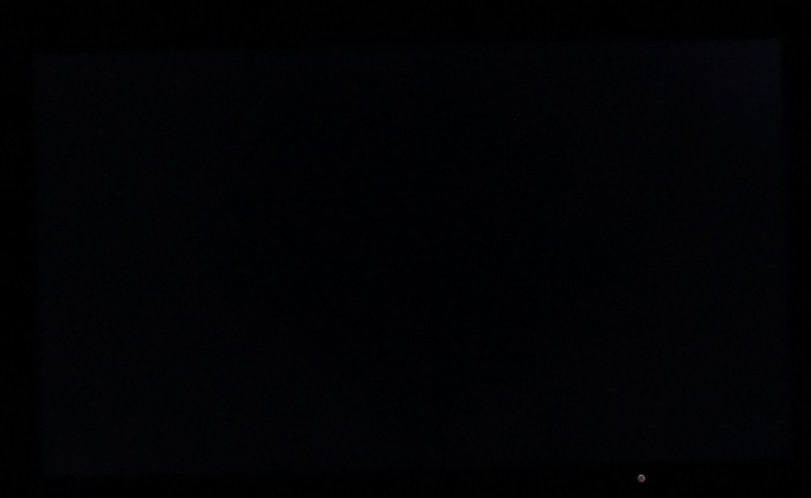
The Spyder5ELITE was used to assess the uniformity of lighter colours, represented by 9 equidistant white quadrants running from the top left to bottom right of the screen. The table below shows the luminance recorded at each quadrant and the percentage deviation between a given quadrant and the brightest point recorded.

Luminance uniformity table

Luminance uniformity map

Colour temperature uniformity map
Contrast in games and movies
Lagom contrast tests
Colour reproduction
Colour gamut

Colour gamut 'Test Settings'

Colour gamut 'sRGB'
Colour in games and movies
Viewing angles
Interlace pattern artifacts
Responsiveness
Input lag
Perceived blur (pursuit photography)
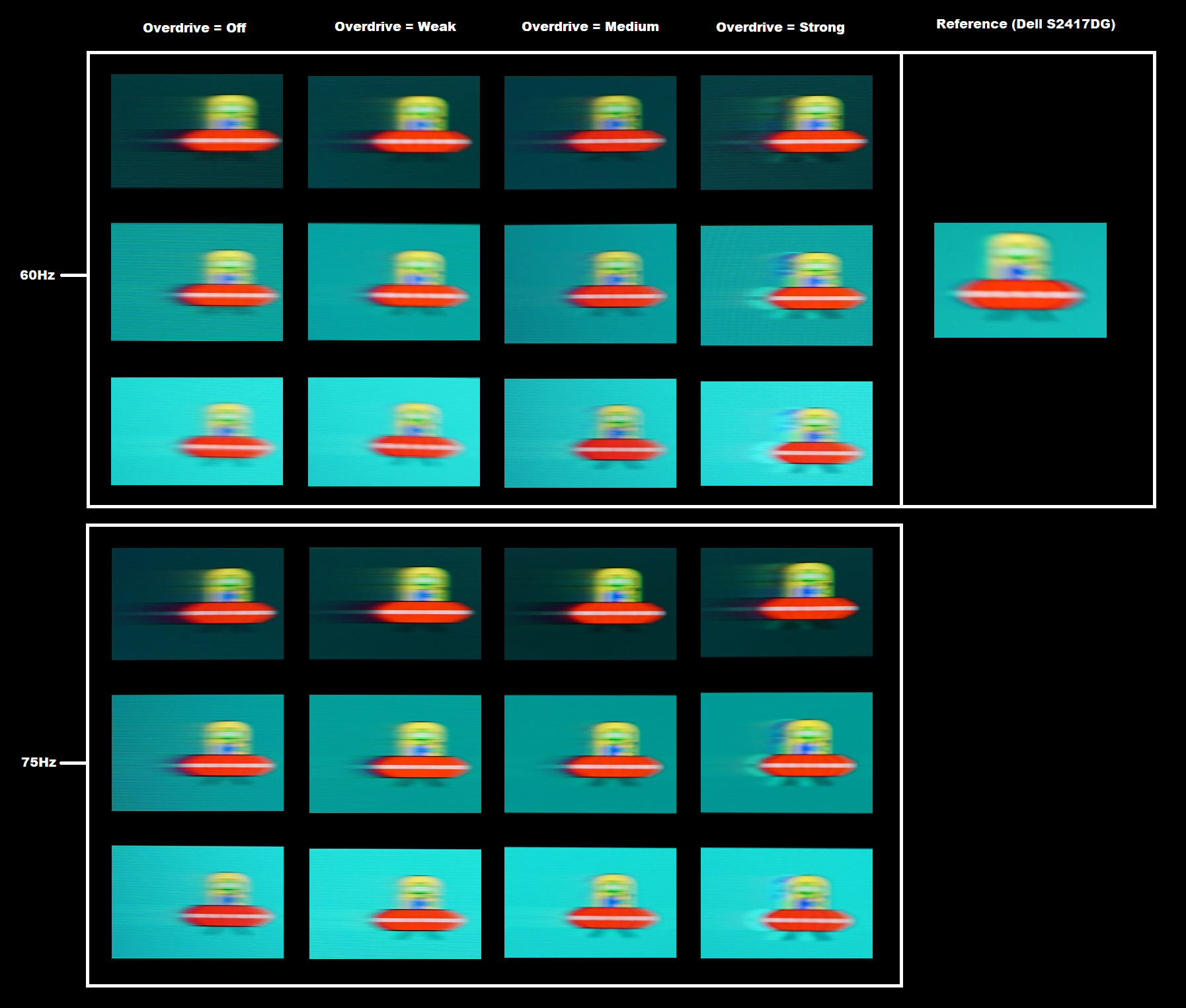
Responsiveness in games and movies
FreeSync – the technology and activating it
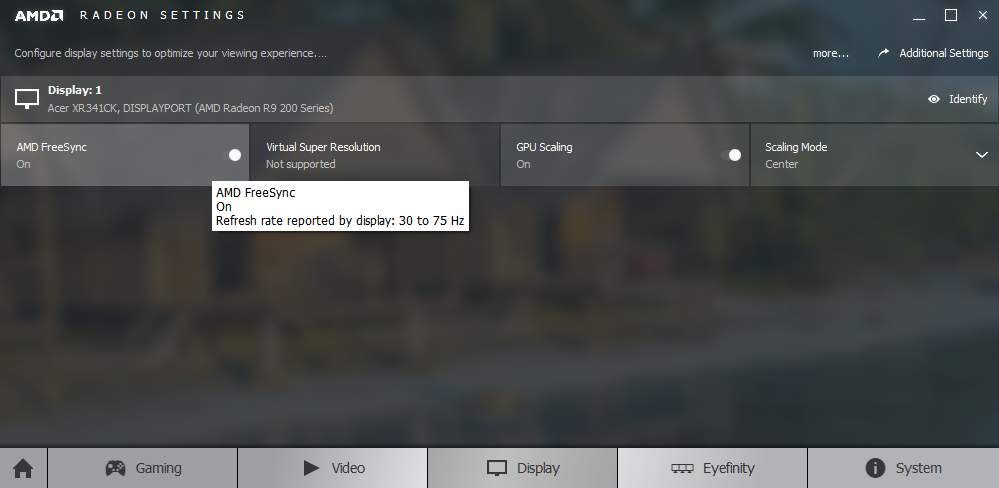
The monitor supports a variable refresh rate range of 48 – 75Hz. That means that if the game is running between 48fps and 75fps, the monitor adjusts its refresh rate to match. When the frame rate rises above 75fps, the monitor will stay at 75Hz and the GPU will respect your selection of ‘VSync on’ or ‘VSync off’ in the graphics driver. With ‘VSync on’ the frame rate will not be allowed to rise above 75fps, at which point VSync activates and imposes the usual associated latency penalty. With ‘VSync off’ the frame rate is free to climb as high as the GPU will output (potentially >75fps). Below the floor of operation (48Hz or 48fps), you will go back to experiencing either stuttering (VSync on) or tearing and juddering (VSync off). This monitor officially supports quite a narrow range of operation for FreeSync, but as per our ‘experience’ section below, it’s best to keep the frame rate from dipping so low anyway. Easier said than done in some cases, of course, and it is always a bonus having the broadest possible variable refresh rate range.
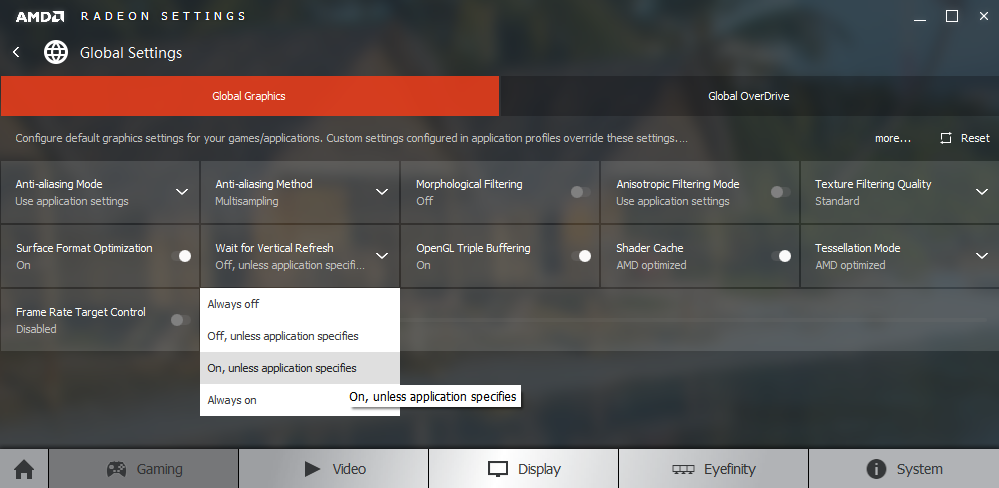
Note that in the ‘Extra’ section of the OSD it will have ‘FreeSync’ listed as the ‘V. Frequency’ if the technology is enabled in the graphics driver, but this does not tell you whether it is currently being used by an application or not. Hopefully the difference that the technology makes in practice will be an obvious enough indication that it is working, however.
FreeSync – the experience
The 31.5″ 2560 x 1440 experience
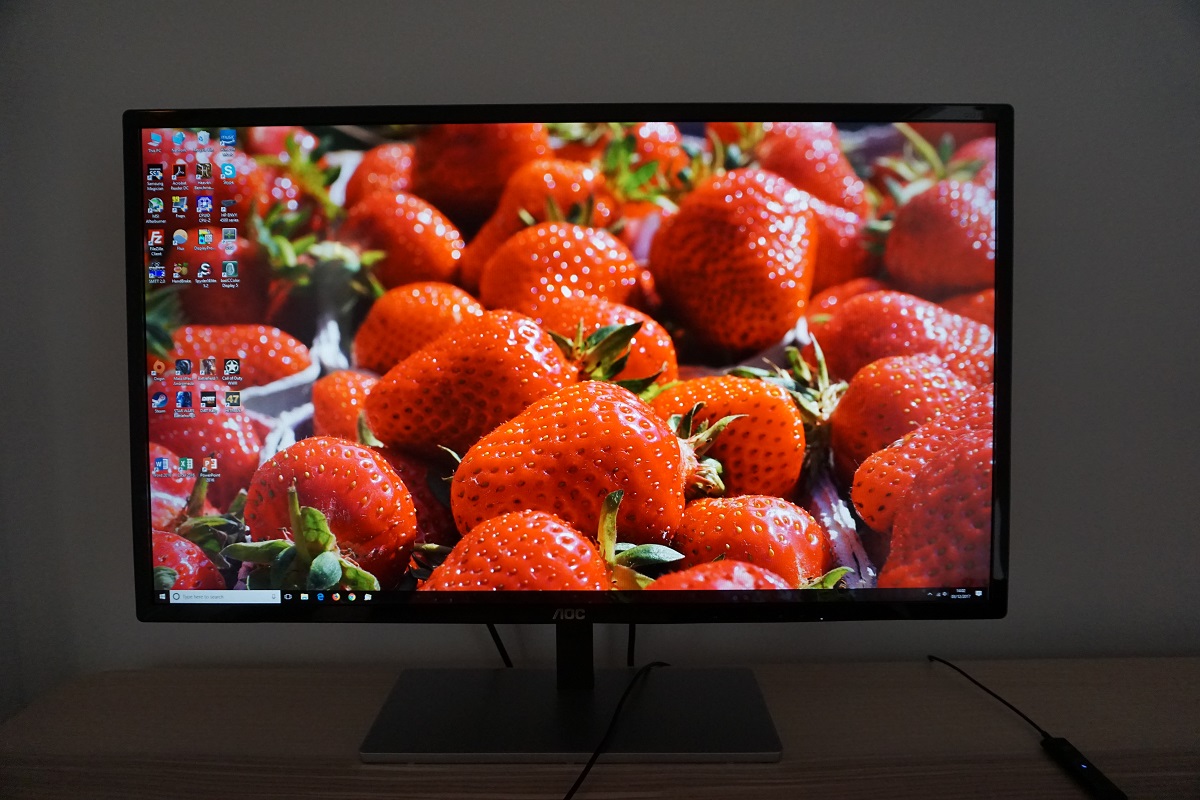
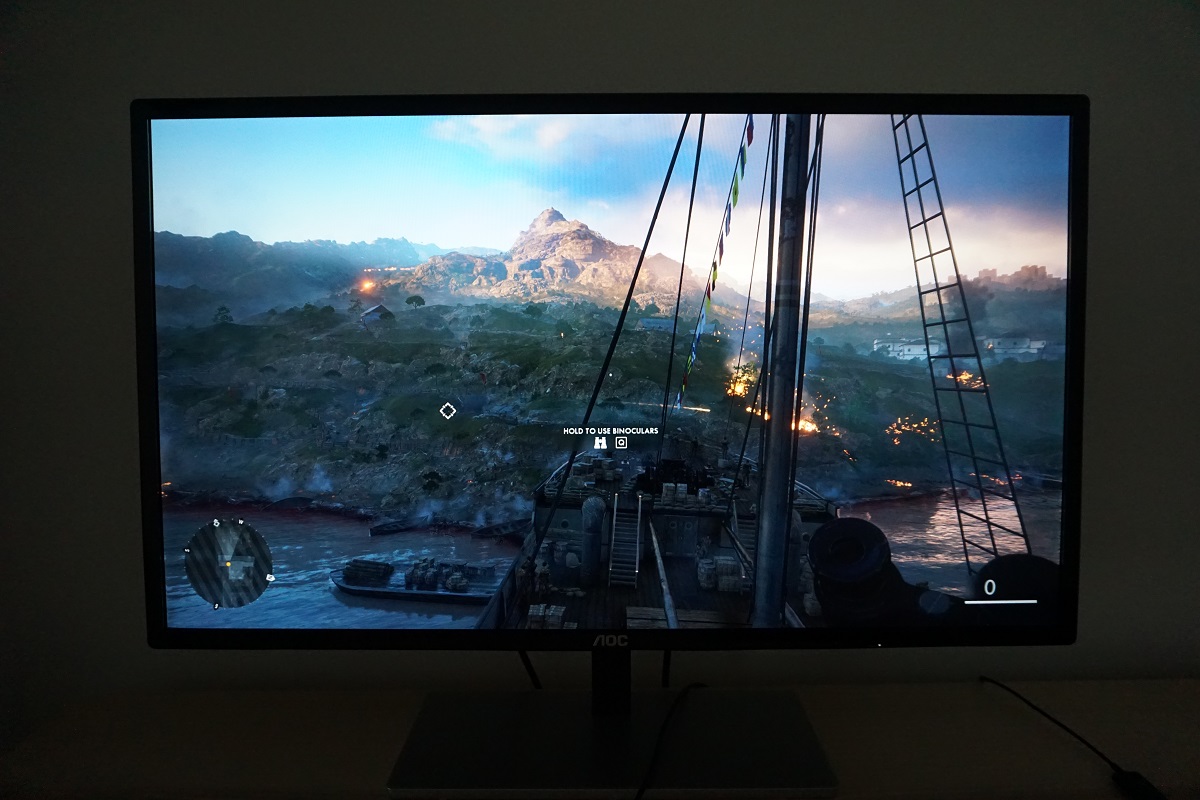
Interpolation and upscaling
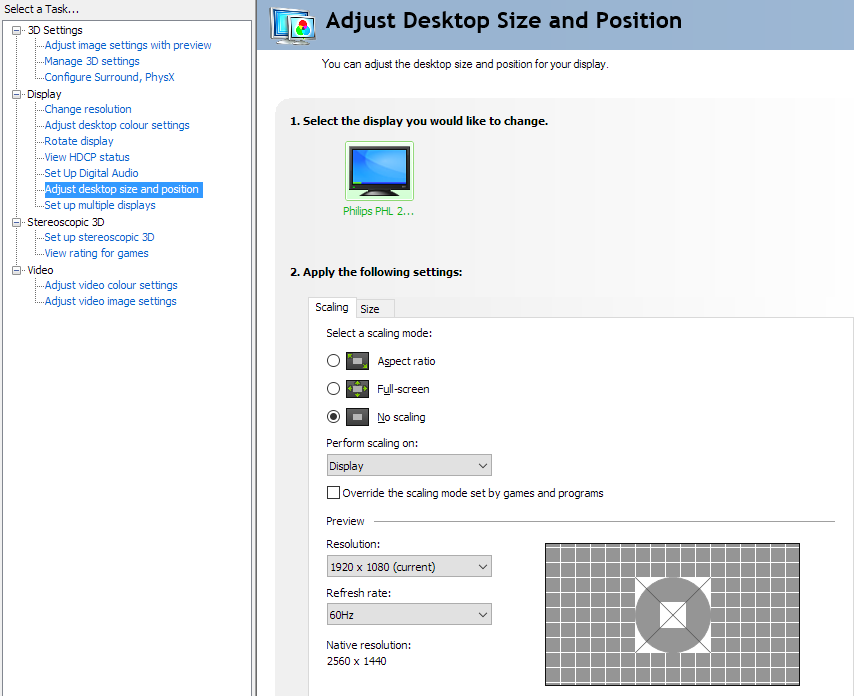
Conclusion
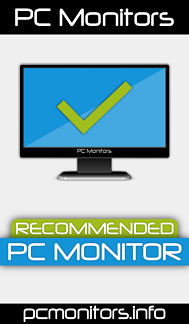
Positives Negatives Decent ‘vibrant pop’ aided by a glossy screen surface and decent colour gamut. Following appropriate calibration the image had good richness, with some shades standing out very nicely (but not in a garish oversaturated way)
Some weaknesses in colour consistency compared to IPS-type models and some other VA models we’ve tested and a colour gamut that’s a bit more restrained than some would like. ICC profile correction required to get the best out of it due to gamma being too low
Excellent static contrast, comfortably exceeding specifications. Coupled with the glossy screen surface, perceived contrast was very strong in a good range of lighting conditions The glossy screen surface requires tighter control of room lighting than matte alternatives. Some ‘black crush’ and ‘VA glow’, as characteristic of the panel type Very low input lag, 75Hz and support for AMD FreeSync (which worked as we’ve come to expect from the technology)
Distinct weaknesses in pixel responsiveness, particularly where dark shades are involved. FreeSync range quite restrictive
Exceptional value for money for a large 2560 x 1440 (WQHD) display, with the screen offering a decent pixel density and plenty of useful work space
Limited ergonomic flexibility and a fairly basic design with limited ports


